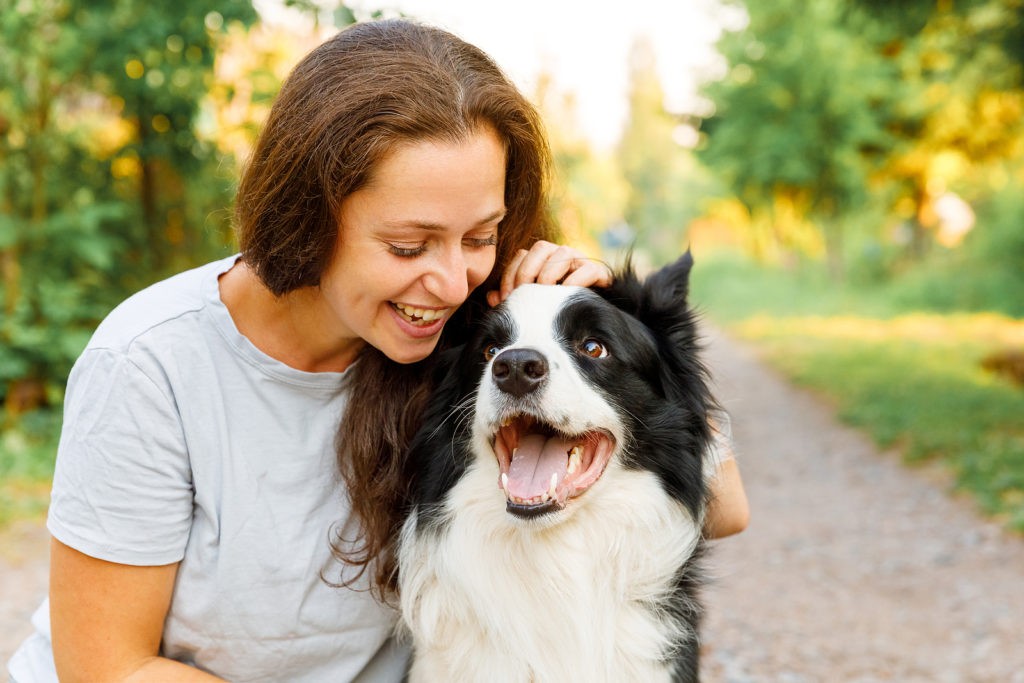Petting a dog is almost a universal language of affection between humans and canines. It’s such a common interaction that many dog lovers might never have paused to wonder why dogs seem to enjoy it so much, or even if they actually like being petted. Unlike many animals who are wary of touch from other species or even unfamiliar members of their own, dogs stand out in their apparent desire for physical contact and displays of affection from humans.
But this desire for touch comes with nuances. Understanding how dogs perceive petting, and learning the right way to interact with them, is crucial, especially when meeting a new furry friend. Let’s explore the fascinating reasons behind why dogs like to be pet and how to make these interactions positive for everyone involved.
 A person petting a Labrador Retriever with affection
A person petting a Labrador Retriever with affection
The Science Behind the Snuggles: Why Dogs Crave Petting
Dogs are inherently social animals, and their bond with humans is particularly deep. For our canine companions, petting is often interpreted as a clear sign of affection and attention from their beloved humans. This isn’t just a guess; scientific research backs this up. Studies have shown that when dogs are petted and given attention by humans, their brains release oxytocin, often dubbed the “love hormone”. Oxytocin is associated with bonding, trust, and feelings of well-being. This hormonal response transforms a simple petting session into a positive and emotionally supportive experience for your dog, significantly contributing to their mental well-being.
Interestingly, this heartwarming exchange isn’t one-sided. The release of oxytocin isn’t exclusive to dogs; humans also experience a surge of this hormone when petting a dog. This mutual release strengthens the human-animal bond and highlights the deeply reciprocal nature of the affection between dogs and their owners.
Where Dogs Love to Be Scratched: Finding the Sweet Spots
While individual preferences vary from dog to dog, and a dog’s receptiveness to petting can depend on the situation or the person initiating the touch, there are general areas where dogs commonly enjoy being scratched. Generally, the chest, neck, and shoulders are considered safe and universally liked zones. These areas are easily accessible and less vulnerable for a dog. Many dogs also appreciate scratches around their ears and along their back. If a dog rolls onto their back, exposing their belly, it’s often an invitation for a belly rub, signifying trust and comfort.
When you are interacting with a dog you don’t know well, it’s always best to start with these generally preferred locations – the chest, neck, and shoulders. As you build familiarity and the dog becomes more comfortable with you, you can gradually explore other areas, paying close attention to their body language to gauge their preferences.
Decoding Doggy Leg Shakes and Ear Sensitivities
Have you ever noticed your dog’s leg involuntarily kicking when you hit just the right spot during a scratch? This amusing leg-shaking phenomenon is a common sight for dog lovers. The reason behind it is surprisingly simple: it’s an involuntary reflex, much like the knee-jerk reaction in humans. When you scratch a dog in a specific spot, you stimulate a nerve that triggers an automatic message to the leg, causing it to kick. While we might find this reflexive kicking endearing, it’s important to remember that the sensation can sometimes be startling or confusing for a dog who doesn’t understand why their body is reacting involuntarily.
Similarly, while ear rubs can be a source of pleasure for dogs, their ears are densely packed with nerve endings, making them quite sensitive. This sensitivity means that while a gentle ear rub can trigger the release of feel-good hormones, some dogs might be apprehensive about having their ears touched, fearing potential discomfort or pain. Therefore, approaching a dog’s ears requires a gentle and cautious approach. Always move slowly, observe the dog’s body language for any signs of nervousness or discomfort, and back off if they seem hesitant.
Head Pats: Proceed with Caution and Build Trust
Despite the common image of patting a dog on the head, many dogs actually don’t appreciate being touched on the top of their heads, especially by unfamiliar people. This aversion often stems from a feeling of vulnerability. From a dog’s perspective, the top of their head can be a sensitive and exposed area. If they don’t fully trust you, a hand reaching over their head can be perceived as a potentially threatening gesture. They might worry about being hurt or dominated.
Unless you have a well-established bond with a dog and know they are comfortable with head pats, it’s generally wiser to focus your petting on other areas, such as the chest, shoulders, or neck, where they are more likely to feel relaxed and at ease. Building trust is key to making head pats a positive interaction.
Petting a Sleeping Pooch: A No-Go Zone for Respectful Interaction
While it might be tempting to offer a comforting pat to a sleeping dog, it’s generally best to resist the urge. Just like humans, dogs can be easily startled when woken up abruptly. Interrupting their sleep can be disruptive and even stressful for them. Moreover, some dogs, if startled awake, might react defensively, potentially leading to nipping or aggression out of fear or confusion.
Even if you have a close bond with a dog, it’s still respectful to let them sleep undisturbed. There are plenty of waking hours to shower them with affection. Avoid situations where you might inadvertently sneak up on a sleeping dog and startle them. Let sleeping dogs lie – it’s a matter of respecting their need for rest and avoiding potential negative reactions.
Benefits Beyond the Belly Rubs: Petting for Calming and Bonding
Petting isn’t just a pleasant interaction; it can also be a valuable tool for managing a dog’s emotional state and strengthening your relationship. If your dog is feeling anxious, stressed, or upset, gentle petting can be an effective way to soothe them and reduce the intensity of their negative emotions. Focus on petting areas where they feel most comfortable, like the chest, shoulders, and neck.
However, it’s important to remember that petting might not be a complete solution for a highly distressed dog. While it can provide comfort and a sense of security, addressing the root cause of their anxiety or stress is crucial. Petting can be a great first step in calming them down, but you should also strive to identify and remove the source of their distress whenever possible. This could involve moving them to a quieter environment, using calming aids like white noise, or providing distractions.
Reading Your Dog’s Petting Preferences: Body Language Speaks Volumes
The key to successful and enjoyable petting sessions lies in paying close attention to your dog’s body language. Dogs communicate their comfort and enjoyment, or discomfort and desire to stop, through subtle cues. Signs that a dog is enjoying being petted include:
- Relaxed body posture: Loose muscles, soft eyes, and a relaxed stance.
- Leaning into the touch: Pressing their body against your hand, seeking more contact.
- Tail wags: Loose and wagging tail (not a stiff, high wag, which can indicate excitement or tension).
- Soft eyes and sometimes closing eyes: Sign of contentment and relaxation.
- Smiling or relaxed mouth: Slightly open mouth, relaxed tongue.
Conversely, signs that a dog is uncomfortable or wants you to stop petting include:
- Turning their head away or moving away: Trying to break contact.
- Stiff body posture: Tense muscles, rigid stance.
- Lip licking or yawning (when not tired): Signs of stress or discomfort.
- Whale eye: Showing the whites of their eyes.
- Growling, snapping, or showing teeth: Clear warning signs to stop immediately.
By learning to read these subtle signals, you can ensure that your petting interactions are always positive and respectful of your dog’s boundaries.
Petting Etiquette: Dos and Don’ts for Happy Interactions
Whether you’re interacting with your own dog or meeting a new one, following some basic petting etiquette ensures positive and safe interactions:
- Always approach gently: Avoid sudden movements or reaching over the dog’s head initially.
- Let them sniff your hand first: Offer your hand and allow the dog to approach and sniff you before attempting to pet them. This gives them a chance to assess you and feel more comfortable.
- Start slowly and in preferred zones: Begin petting in generally liked areas like the chest, neck, or shoulders.
- Avoid forcing interaction: If a dog seems hesitant or moves away, don’t force petting. Respect their space and comfort level.
- Pay attention to body language: Continuously monitor the dog’s cues and adjust your petting accordingly.
- Supervise children: Always supervise children when they are petting dogs to ensure gentle and respectful interactions.
By being mindful and respectful of dog’s preferences and boundaries, petting can become a wonderful way to strengthen the bond between humans and their canine companions, bringing joy and comfort to both.
